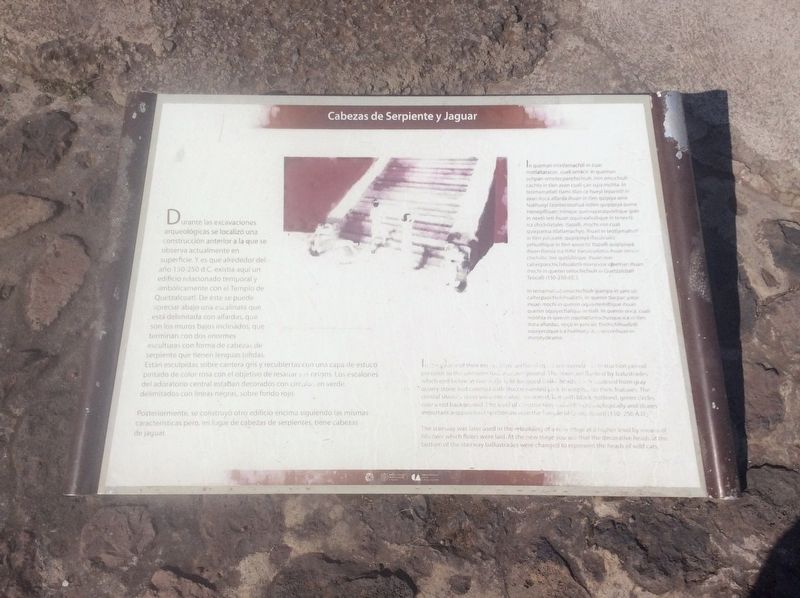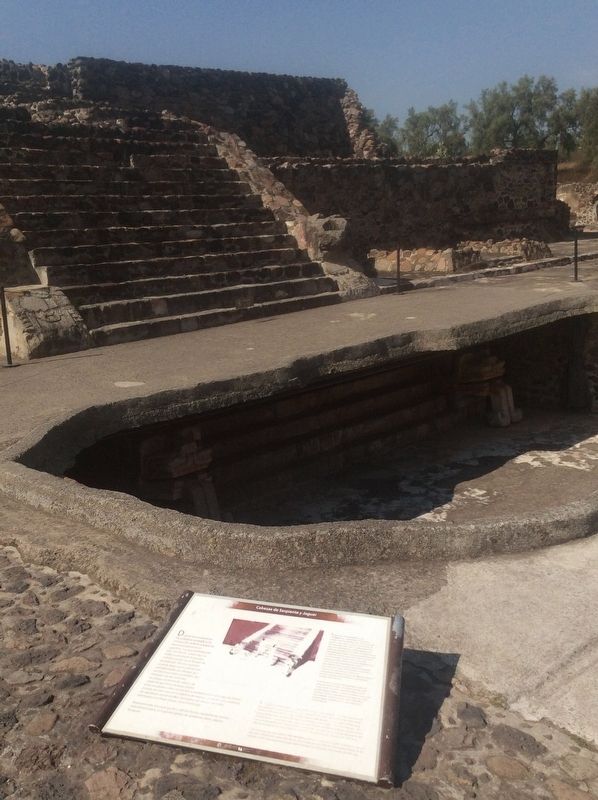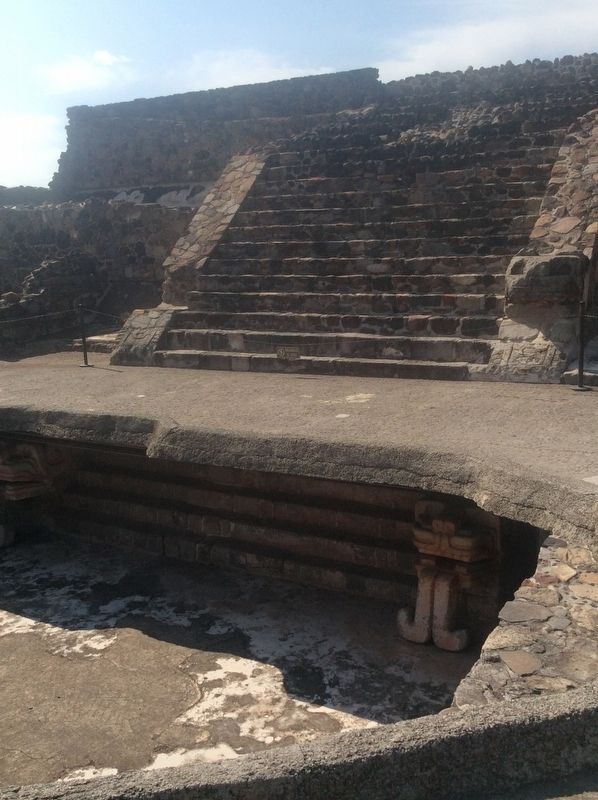Teotihuacán de Arista in Teotihuacán, Mexico State, Mexico — The Central Highlands (North America)
Jaguar and Serpent Heads
Inscription.
Cabezas de Serpiente y Jaguar
Durante las excavaciones arqueológicas se localizó una construcción anterior a la que se observa actualmente en superficie. Y es que alrededor del año 150-250 d.C existía aquí un edificio relacionado temporal y simbólicamente con el Templo de Quetzalcoatl. De éste se puede apreciar abajo una escalinata que son los muros bajos inclinados, que terminan con dos esculturas con forma de cabezas de serpiente que tienen lenguas bífidas. Están esculpidas sobre cantera gris y recubiertas con una capa de estuco pintado de color rosa con el objetivo de resaltar sus rasgos. Los escalones del adoratorio central estaban decorados con círculos en verde, delimitados con líneas negras, sobre fondo rojo.
Posteriormente, se construyó otro edificio encima siguiendo las mismas características pero, en lugar de cabezas de serpientes, tiene cabezas de jaguar.
Cabezas de Serpiente y Jaguar
In queman mixtlamachili in cauc motlaltatacoc, cuali omacic in queman cehpan omotecpanchichiuh, inin omuchiuh cachto in tlen axan cuali can ixpa mohta. In teomamatlati tlami itlan ce hueyi tepamitl in axan itoca alfarda ihuan in tlen quipiya ome huehueyi tzontecocohua intlen quipipya oome inenepilhuan: ininque quinxayacaquixtique ipan in nextli tetl ihuan oquinkahuilique in tenextli ica chichiliztalec tlapalli, mochi inin cual quixpantia itlatlamachyo. Ihuan in teotlamamatl in tlen yolocate, quipipiaya tlacuicuiliz yehualtique in tlen xoxoctic tlapalli quipipiaya ihuan tlamia ica tliltic tlacuicuiliztin ihuan mochi chichiltic itec quitlalilique. Ihuan inin caltecpanchichihualiztli mixnextia iqueman ihuan mochi in quenin omochichiuh in Quetzalcoatl Teocalli (150-250 d.C.).
In temamatlatl omochichiuh ipampa in yancuic caltecpanchichihualixtli, in quenin tlacpac yatoc ihuan mochi in quenin oquitetemiltique ihuan quenin oquiyectlalique in tlalli. In quenin onca, cuali moohta in quenin oquitlatlamachyoque ica in tlen itoca alfardas, noco in yancuic tlachichihualiztli oquiyecoque ica huehueyi inteconhuan in mimizyolcame.
Jaguar and Serpent Heads
In the course of their excavations, archaeologists uncovered a construction period previous to the one seen today above ground. The stairs are flanked by balustrades which end below in two huge split-tongued snake heads, each sculpted from gray quarry stone and covered with stucco painted pink to emphasize their features. The central shrine’s stairs were
once also decorated, but with black-outlined, green circles over a red background. This level of construction coincides chronologically and shares important architectural symbolism with the Temple of Quetzalcoatl (150-250 A.D.).
The stairway was later used in the rebuilding of a new stage at a higher level by means of fills over which floors were laid. At the new stage you see that the decorative heads at the bottom of the stairway ballustrades were changed to represent the heads of wild cats.
Erected by Instituto Nacional de Antropología e Historia (INAH).
Topics. This historical marker is listed in these topic lists: Anthropology & Archaeology • Architecture • Churches & Religion • Native Americans.
Location. 19° 41.303′ N, 98° 50.867′ W. Marker is in Teotihuacán de Arista, Estado de Mexico (Mexico State), in Teotihuacán. Marker can be reached from Calle Paloma just west of Calle Tuxpan. Touch for map. Marker is in this post office area: Teotihuacán de Arista MEX 55880, Mexico. Touch for directions.
Other nearby markers. At least 8 other markers are within walking distance of this marker. West Plaza Complex (within shouting distance of this marker); Plaza B of the Avenue of the Dead Complex (within shouting distance of this marker); Avenue of the Dead Complex (within shouting distance of this marker); Plaza A of the Avenue of the Dead Complex
(about 120 meters away, measured in a direct line); Plaza C of the Avenue of the Dead Complex (about 120 meters away); Northwest San Juan River Complex (approx. 0.3 kilometers away); Teotihuacan After Its Abandonment (approx. half a kilometer away); Construction Systems of the Pyramid of the Sun (approx. half a kilometer away). Touch for a list and map of all markers in Teotihuacán de Arista.
Credits. This page was last revised on July 28, 2023. It was originally submitted on December 18, 2017, by J. Makali Bruton of Accra, Ghana. This page has been viewed 155 times since then and 10 times this year. Photos: 1, 2, 3. submitted on December 18, 2017, by J. Makali Bruton of Accra, Ghana.


